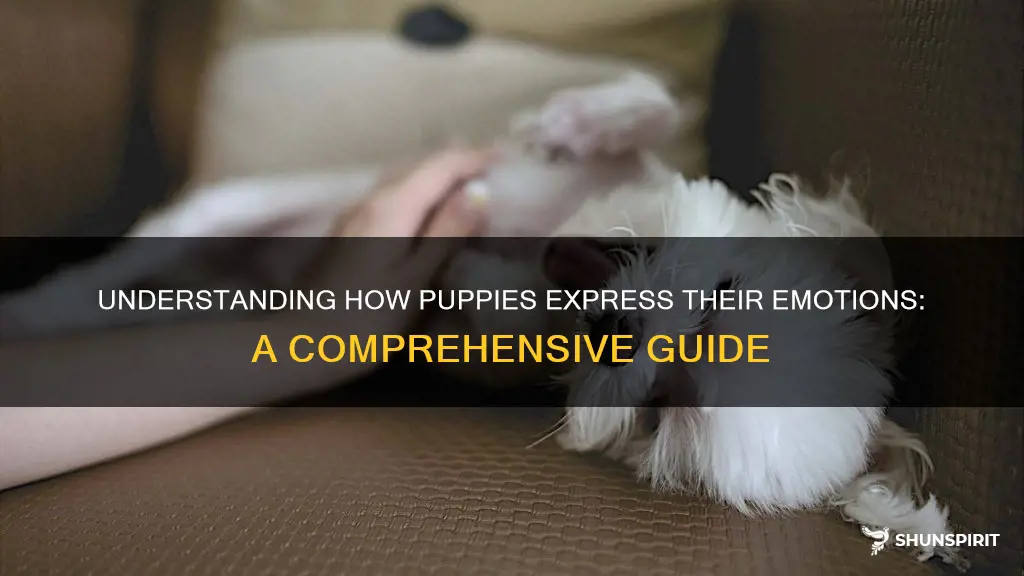
A puppy's cute little face can often tell us a lot about their emotions. From the wagging of their tail to the tilt of their head, puppies have a unique way of expressing how they're feeling. Whether they're happy, excited, or anxious, their emotions are written all over their furry faces. So, if you've ever wondered how your puppy really feels, just take a look at their expressive eyes and playful antics, and you'll understand their emotions in an instant.
| Characteristics | Values |
|---|---|
| Tail wagging | Excitement, happiness |
| Ears forward | Attention, interest |
| Ears back | Anxiety, fear |
| Play bow | Invitation to play |
| Jumping up | Excitement, attention-seeking |
| Barking | Alertness, fear, aggression |
| Whining | Anxiety, attention-seeking |
| Pawing | Attention-seeking, excitement |
| Licking | Affection, submission |
| Rolling over | Submission, trust |
| Squinty eyes | Friendliness, relaxation |
| Dilated pupils | Fear, aggression |
| Tail tucking | Fear, anxiety |
| Hackles raised | Fear, aggression |
| Panting | Overheating, anxiety |
| Yawning | Stress, tiredness |
| Growling | Aggression, warning |
| Snarling | Aggression, threat |
| Cowering | Fear, submission |
What You'll Learn

Heading: Understanding a Puppy's Emotions
As a responsible puppy owner, it is essential to understand and interpret your furry friend's emotions. Puppies, like adult dogs, rely on a combination of vocalizations, body language, and facial expressions to express themselves. By learning to recognize and interpret these signals, you can effectively communicate and meet your puppy's needs. In this article, we will explore different ways puppies show their emotions, focusing on vocalizations, body language, and facial expressions.
Different Ways Puppies Show Their Emotions:
Vocalizations:
Puppies use various vocalizations to express their emotions. Understanding these vocal cues is crucial to understanding your puppy's needs. Here are some common vocalizations and what they mean:
A. Whining: Puppies whine to communicate their discomfort, fear, or anxiety. It could be a sign that they need to go outside, have separation issues, or are seeking attention.
B. Barking: Puppies bark to signal a variety of emotions, including excitement, fear, or frustration. Each type of bark is accompanied by different body language cues, so it's important to observe your puppy's behavior to get a better understanding of their emotions.
Body Language:
A puppy's body language is another significant indicator of their emotions. By observing their posture, movements, and gestures, you can gain valuable insights into what they're feeling. Here are some key body language cues to look out for:
A. Tail wagging: A wagging tail can indicate that a puppy is happy and excited. However, it's important to pay attention to the context and accompanying body language to determine if the wagging is a sign of friendly or aggressive behavior.
B. Ears: The position and movement of a puppy's ears can convey important information about their emotional state. Ears held back or flattened against the head often indicate fear or submission, while ears perked up suggest alertness or curiosity.
C. Posture: A confident puppy will have an upright posture, while a fearful or submissive puppy may cower, lower their body, or tuck their tail between their legs. Understanding these postural cues can help you gauge your puppy's confidence levels and emotional well-being.
Facial Expressions:
Puppies' facial expressions provide valuable insights into their emotions, just like humans. Pay attention to their eyes, mouth, and overall facial movement for a clearer understanding of their emotional state. Here are some common facial expressions and what they indicate:
A. Raised eyebrows and relaxed eyes: A puppy with raised eyebrows, relaxed eyes, and a loose mouth is likely feeling relaxed and content.
B. Baring teeth: If a puppy bares their teeth or shows their gums, it's a clear sign of aggression or fear. Back away and give the puppy space to calm down.
C. Lip licking: Puppies often lick their lips when they feel anxious or stressed. It's a self-soothing behavior that signals their discomfort.
Understanding your puppy's emotions is an essential part of building a strong bond and ensuring their well-being. By paying attention to their vocalizations, body language, and facial expressions, you can gain valuable insights into their emotional state and respond accordingly. Remember, each puppy is unique, so take the time to observe and learn about your furry friend's specific ways of expressing their emotions.
How Emotionally Intelligent People Harness the Power of Rethinking for Success
You may want to see also

Heading: Vocalizations
Puppies, just like human babies, communicate their needs and emotions through vocalizations. It is important for puppy owners to understand the different types of sounds puppies make in order to accurately interpret their behavior and respond appropriately. In this article, we will explore the various vocalizations of puppies, including barking, whining, and growling, along with what each sound may indicate.
Types of Sounds Puppies Make
Puppies have a wide range of vocalizations at their disposal. These include barking, whining, growling, yelping, and howling. Each sound has its own distinct meaning and purpose, and by paying attention to these sounds, you can develop a better understanding of your puppy's needs.
Barking
Barking is perhaps the most familiar sound that puppies make. It can indicate a range of emotions including alertness, excitement, fear, or aggression. For example, if your puppy barks when a stranger approaches, it is likely a response to fear or defensiveness. However, if your puppy barks when they see a toy or are anticipating playtime, it is a sign of excitement and anticipation.
Whining
Whining is a vocalization commonly used by puppies to express their needs or emotions. It can indicate anxiousness, discomfort, or simply a desire for attention. Puppies may whine when they are hungry, thirsty, or need to go outside to relieve themselves. They may also whine when they are in pain or feeling stressed. It is important to pay attention to the context in which your puppy is whining to determine the appropriate response.
Growling
Growling is a vocalization that can be a warning of aggression or playfulness. When puppies growl, it is important to assess the situation to determine the underlying emotion. If your puppy growls when someone tries to take away a toy or food, it may be a sign of possessiveness and aggression. On the other hand, if your puppy growls during playtime, it is likely a sign of excitement and enjoyment.
What Each Sound May Indicate
Understanding the underlying emotions behind your puppy's vocalizations is crucial for effective communication and training. Here is a breakdown of what each sound may indicate:
- Barking: Barking can indicate alertness, excitement, fear, or aggression. Pay attention to the context and body language of your puppy to determine the underlying emotion.
- Whining: Whining can indicate anxiousness, discomfort, or a need for attention. Assess the situation and address your puppy's needs accordingly.
- Growling: Growling can be a warning of aggression or playfulness. Analyze the context and body language of your puppy to interpret the motivation behind the growling.
By being attentive and observant, you can develop a better understanding of your puppy's vocalizations and respond appropriately. Remember that each puppy is unique, and it may take time to fully understand your puppy's specific vocalization patterns. Patience and consistent training will help foster clear communication between you and your furry friend.
The Impact of ICTs on Promoting Emotional Intelligence: A Comprehensive Analysis
You may want to see also

Heading: Body Language
Body language is a vital form of communication for dogs. It allows them to express their emotions, intentions, and even their overall well-being. As a dog owner, it's important to understand and interpret your dog's body language to better understand their needs and feelings. In this blog post, we will explore some key aspects of dog body language, including postures and movements, tail wagging, ears position, body posture, and yawning.
Postures and Movements
One of the primary ways dogs communicate through body language is through their postures and movements. Paying attention to how your dog holds themselves and moves can provide valuable insights into their emotions and intentions. Here are some common postures and movements to be aware of:
- Relaxed posture and loose movements: This is a sign that your dog is comfortable and at ease. Their body will appear relaxed, and their movements will be smooth and fluid.
- Stiff posture and tense movements: A stiff and tense posture indicates that your dog is alert or potentially fearful. Their movements will be rigid and jerky.
- Low posture and slow movements: This posture suggests that your dog is feeling submissive or fearful. They may lower their body closer to the ground and move slowly to avoid confrontations.
- Tucked tail and lowered body: If your dog tucks their tail between their legs and lowers their body, it indicates extreme fear or submission. This is a clear sign that they feel threatened and may need reassurance.
Tail Wagging
Contrary to popular belief, tail wagging doesn't always mean happiness. The position and rhythm of the wag can provide clues about your dog's emotional state. Here are some tail wagging patterns and their interpretations:
- Slow, wide wag: This wag usually indicates relaxation and contentment. It shows that your dog is feeling calm and comfortable.
- Quick, high wag: A fast and high tail wag typically signifies excitement or arousal. It indicates that your dog is happy to see you or anticipating something exciting.
- Low, slow wag: A low and slow tail wag can be a sign of nervousness or fear. It suggests that your dog is feeling unsure or apprehensive about a situation.
Ears Position
The position of your dog's ears can also provide insight into their emotional state. Here are some common ear positions and their interpretations:
- Erect ears pointed forward: This position indicates that your dog is alert and attentive. They are probably focused on something of interest or potentially a threat.
- Flattened ears: When your dog's ears are flat against their head, it suggests fear or submission. They may be trying to appear smaller and less threatening.
Body Posture
A dog's body posture can speak volumes about their confidence, fear, submission, or aggression. Here are some key body postures and what they mean:
- Relaxed body posture: A relaxed body posture indicates that your dog is comfortable and at ease. Their muscles will be loose, and they may have a slight lean to one side.
- Tense, raised body posture: If your dog appears tense, with raised hackles and a stiff body, it suggests that they are on high alert and potentially ready to defend themselves.
- Cowering body posture: A cowering body posture, with lowered head and tucked tail, indicates extreme fear or submission. Your dog may try to make themselves appear smaller to avoid confrontations.
Yawning
Yawning is not always a sign that your dog is tired; it can also be a form of communication. Here are some possible interpretations of yawning in dogs:
- Stress or anxiety: Yawning can indicate that your dog is experiencing stress or anxiety. It is their way of trying to calm themselves down or signal discomfort.
- Tiredness: Of course, yawning can also be a sign that your dog is tired and in need of rest. It's important to pay attention to their overall behavior and context to determine if tiredness is the cause.
Interpretation of Body Language
Understanding and interpreting your dog's body language is crucial for effective communication and ensuring their well-being. By paying close attention to their postures, tail wagging, ears position, body posture, and even yawning, you can gain valuable insights into their emotions and needs. Remember that each dog is unique, and it's essential to consider the context and individual differences when interpreting their body language. By developing your skills in reading their cues, you can strengthen the bond between you and your furry friend and provide them with the support and care they need.
The Power of Emotional Intelligence: Understanding the Significance of Having a High EQ
You may want to see also

Heading: Facial Expressions
Facial expressions are a fundamental aspect of human communication. They convey a wide range of emotions and play a crucial role in expressing our thoughts and feelings. Understanding common facial expressions can help you decipher the underlying emotions and intentions of others. In this article, we will explore the meaning behind some commonly recognized facial expressions, including the happy face, sad face, fearful face, and relaxed face.
Happy Face: Contentment, Joy, or Playfulness
The happy face is perhaps the most universally recognized expression. It is characterized by a smile, typically accompanied by bright eyes and lifted cheeks. A happy face signifies feelings of contentment, joy, or playfulness. When you see someone with a happy face, it usually means they are experiencing positive emotions and are likely to be open to interaction. If you come across a person with a happy face, it's a good opportunity to connect with them, share some laughter, and enjoy a pleasant conversation.
Sad Face: Distress, Discomfort, or Illness
The sad face is characterized by a downward curve of the mouth, drooping eyelids, and a generally somber expression. It signifies feelings of distress, discomfort, or illness. When someone wears a sad face, they may be going through a difficult time or experiencing some form of emotional or physical pain. It is important to approach someone with a sad face with empathy and kindness. A compassionate conversation or a simple act of support can go a long way in lifting their spirits and providing comfort.
Fearful Face: Anxiety, Fear, or Submission
The fearful face is marked by widened eyes, raised eyebrows, and a tense expression. It conveys emotions of anxiety, fear, or submission. When someone wears a fearful face, it indicates that they may feel threatened or unsafe in their environment. It is important to approach someone with a fearful face with care and respect their boundaries. Reassurance and understanding can help alleviate their fears and create a sense of safety.
Relaxed Face: Calmness, Relaxation, or Contentment
The relaxed face is characterized by a neutral expression, soft features, and a general sense of ease. It signifies feelings of calmness, relaxation, or contentment. When someone wears a relaxed face, it suggests that they are at peace with their surroundings and are likely in a positive state of mind. Engaging with someone who has a relaxed face can create a friendly and tranquil atmosphere. It is an opportunity to connect on a deeper level and share moments of serenity.
Understanding the meaning behind common facial expressions enables us to respond appropriately to the emotions and needs of others. Whether it is a happy face, sad face, fearful face, or relaxed face, each expression provides valuable insight into a person's state of mind. By being attentive to facial expressions, we can foster empathy, establish meaningful connections, and create a supportive and understanding community. So, next time you encounter someone with a particular facial expression, take a moment to consider its meaning and respond with compassion.
Finding Freedom: How to Walk Away from an Emotionally Abusive Relationship
You may want to see also
Frequently asked questions
Puppies show their happiness by wagging their tails, jumping, and bounding around with excitement. They may also lick and nuzzle their owners or playfully invite them to engage in a game.
Puppies show their fear by trembling, cowering or hiding, and showing signs of submission. They may also bark or growl in an attempt to appear intimidating, even though they are actually scared.
Puppies show their sadness by becoming withdrawn and lethargic. They may lose interest in their usual activities and exhibit signs of loss of appetite. They may also whine or whimper and seek comfort from their owners.
Puppies show their aggression by growling, barking, and snarling. They may also lunge or bite when they feel threatened or provoked. Their body language, such as an erect tail or raised hackles, may also indicate aggression.







